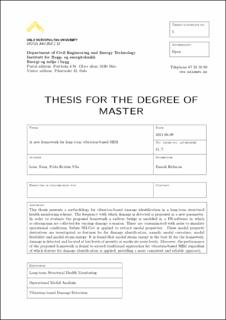| dc.description.abstract | This thesis presents a methodology for vibration-based damage identification in a long-term structural health monitoring scheme. The frequency with which damage is detected is proposed as a new parameter. In order to evaluate the proposed framework a railway bridge is modeled in a FE-software in which accelerograms are collected for varying damage scenarios. These are contaminated with noise to simulate operational conditions, before SSI-Cov is applied to extract modal properties. Three modal property derivatives are investigated as features for for damage identification, namely modal curvature, modal flexibility and modal strain energy. It is found that modal strain energy is the best fit for the framework; damage is detected and located at low levels of severity at moderate noise levels. Moreover, the performance of the proposed framework is found to exceed traditional approaches for vibration-based SHM regardless of which feature for damage identification is applied, providing a more consistent and reliable approach. | en_US |
